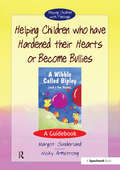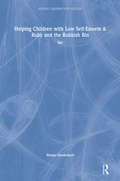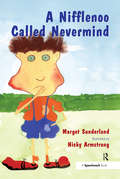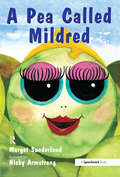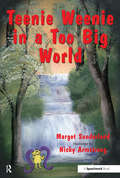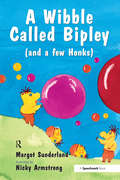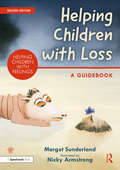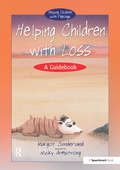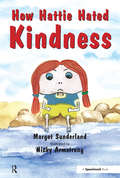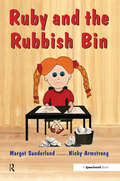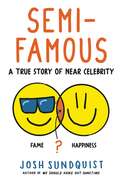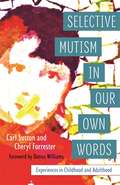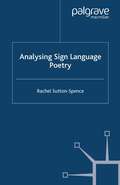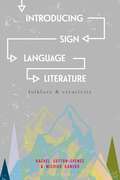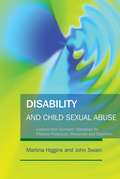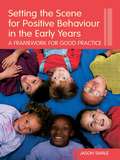- Table View
- List View
Helping Children who have hardened their hearts or become bullies: A Guidebook (Helping Children with Feelings)
by Margot SunderlandThis is a guidebook to help children who: - bully or take revenge on others for the pain they have felt themselves - have become very defensive because something too painful has happened to them - have hardened their hearts because they have: been too hurt in love; met with too much harshness; witnessed parental violence; been repeatedly hit; been shamed or humiliated; or - had too many experiences of not being responded to - think they have lost their parent's love to someone else and have hardened their heart.
Helping Children with Low Self-Esteem & Ruby and the Rubbish Bin: Set (Helping Children with Feelings)
by Margot SunderlandThis practical guidebook, with a beautifully-illustrated storybook, enables teachers, parents and professionals to help children aged 4-12 connect with unresolved feelings affecting their behaviour. Helping Children with Low Self-Esteem is a guidebook to help children who: don't like themselves or feel there is something fundamentally wrong with them have been deeply shamed have received too much criticism or haven't been encouraged enough let people treat them badly because they feel they don't deserve better do not accept praise or appreciation because they feel they don't deserve it feel defeated by life, fundamentally unimportant, unwanted or unlovable bully because they think they are worthless or think they are worthless because they are bullied and, feel they don't belong or do not seek friends because they think no-one would want to be their friend. Ruby and the Rubbish Bin is a story for children with low self-esteem. Ruby hates herself so much that she often feels more like a piece of rubbish than a little girl. Sometimes Ruby feels so miserable that she wants to sleep and sleep and never wake up again. Then Ruby meets Dot and, over time, Dot helps Ruby to move from self-hate to self-respect. After a very important dream, and help from Dot, Ruby finds her voice and her anger, and stands up to the bullies. She makes new friends and knows what it's like to feel happy for the first time in her life.
A Nifflenoo Called Nevermind: A Story for Children Who Bottle Up Their Feelings (Helping Children with Feelings)
by Margot SunderlandA story for children who bottle up their feelings. Nevermind always carries on whatever happens! Each time something horrible happens to him he just tucks his feelings away and carries on with life. Find out what happens to Nevermind and how he begins to understand that his feelings do matter, how he learns to express them and stand up for himself.
A Pea Called Mildred: A Story to Help Children Pursue Their Hopes and Dreams (Helping Children with Feelings)
by Margot SunderlandA story to help children pursue their hopes and dreams. Mildred is a pea with dreams. She has great plans for her pea life. However, people are always telling her that dreams are pointless as she is just another ordinary pea. Eventually, with the help of a kind person along the way, Mildred ends up doing exactly what she has always dreamed of doing.
Teenie Weenie in a Too Big World: A Story for Fearful Children (Helping Children with Feelings)
by Margot Sunderland(A story for fearful children) One day Teenie Weenie finds himself in a scrumbly screechy place. It is full of noises and crashes and things that swoop and scratch. The worse it gets, the smaller Teenie Weenie feels. After a while, he feels so small that the tiniest insect tries to eat him up. Teenie Weenie feels terrified and desperately alone. But after a while along strolls a Wip-Wop bird who invites Teenie Weenie to come and have a chocolate muffin in his tree house. With the Wip Wop bird and his friend Hoggie, Teenie Weenie learns for the first time in his life all about the power of TOGETHER. He comes to know how very different things look when it's an US not just a ME. And so after that, whenever Teenie Weenie finds himself struggling alone with something too difficult or too frightening, he goes off and finds some TOGETHER.
Teenie Weenie in a Too Big World: A Story for Fearful Children (Helping Children with Feelings)
by Margot Sunderland(A story for fearful children) One day Teenie Weenie finds himself in a scrumbly screechy place. It is full of noises and crashes and things that swoop and scratch. The worse it gets, the smaller Teenie Weenie feels. After a while, he feels so small that the tiniest insect tries to eat him up. Teenie Weenie feels terrified and desperately alone. But after a while along strolls a Wip-Wop bird who invites Teenie Weenie to come and have a chocolate muffin in his tree house. With the Wip Wop bird and his friend Hoggie, Teenie Weenie learns for the first time in his life all about the power of TOGETHER. He comes to know how very different things look when it's an US not just a ME. And so after that, whenever Teenie Weenie finds himself struggling alone with something too difficult or too frightening, he goes off and finds some TOGETHER.
A Wibble Called Bipley: A Story for Children Who Have Hardened Their Hearts or Becomes Bullies (Helping Children with Feelings)
by Margot SunderlandA story for children who have hardened their hearts or become bullies. Bipley is a warm cuddly creature, but someone has broken his heart. He feels so hurt that he decides it is just too painful to ever love again. When he meets some big tough Honks in the wood, they teach him how to harden his heart so that he doesn't have to feel hurt any more. Luckily Bipley meets some creatures who teach him how he can protect himself without hardening his heart.
The Day the Sea Went Out and Never Came Back: A Story for Children Who Have Lost Someone They Love (Helping Children with Feelings)
by Margot Sunderland Nicky ArmstrongEric is a sand dragon who loves the sea very much. Each day, he watches it go out, knowing that it will return. But one day, Eric waits and waits, but it does not come back. He falls on the sand, feeling as if he has lost everything. Eric wants to shut himself off from his feelings, but eventually spots a little wildflower growing, and another, and another. He builds a rock pool garden, in memory of the sea that he loves, and learns that it is much better to feel the full pain of his loss, instead of closing his heart. The Day the Sea Went Out and Never Came Back is a story for children who have lost someone they love. The beautiful illustrations and sensitively written story offer a wealth of opportunities to begin a conversation about the difficult emotions that can follow a loss, helping children to acknowledge and express their emotions. The story shows them that it is brave to feel sad, that they are surrounded by support, and that memories of a loved one are a special treasure that can never be lost. Ideal for starting conversations about grief and sadness, this is an essential resource for anybody supporting children aged 4-12 who have experienced loss.
Helping Children with Loss: A Guidebook (Helping Children with Feelings)
by Margot Sunderland Nicky ArmstrongNow in a fully updated second edition, this professional guidebook has been created to help adults provide emotional support for children who have experienced the loss of somebody they know, or something they loved. Written in an accessible style and with a sensitive tone, Helping Children with Loss provides adults with a rich vocabulary for mental states and painful emotions, paving the way for meaningful and healing conversations with children who are struggling with difficult feelings. Practical activities provide opportunities for conversation and will empower the child to find creative and imaginative ways of expressing themselves when words fail. Key features of this resource include: Targeted advice for children who defend against feeling their painful feelings by dissociating from grief Tools and strategies for helping children cope with loss, including engaging activities to help children explore their feelings in a non-threatening way Photocopiable and downloadable resources to help facilitate support Written by a leading child psychotherapist with over thirty years’ experience, this book will support children to develop emotional literacy and connect with unresolved feelings affecting their behaviour. It is an essential resource for anybody supporting children aged 4-12 who have experienced loss.
Helping Children with Loss: A Guidebook (Helping Children with Feelings)
by Margot Sunderland Nicky ArmstrongNow in a fully updated second edition, this professional guidebook has been created to help adults provide emotional support for children who have experienced the loss of somebody they know, or something they loved. Written in an accessible style and with a sensitive tone, Helping Children with Loss provides adults with a rich vocabulary for mental states and painful emotions, paving the way for meaningful and healing conversations with children who are struggling with difficult feelings. Practical activities provide opportunities for conversation and will empower the child to find creative and imaginative ways of expressing themselves when words fail. Key features of this resource include: Targeted advice for children who defend against feeling their painful feelings by dissociating from grief Tools and strategies for helping children cope with loss, including engaging activities to help children explore their feelings in a non-threatening way Photocopiable and downloadable resources to help facilitate support Written by a leading child psychotherapist with over thirty years’ experience, this book will support children to develop emotional literacy and connect with unresolved feelings affecting their behaviour. It is an essential resource for anybody supporting children aged 4-12 who have experienced loss.
Monica Plum's Horrid Problem (Helping Children with Feelings)
by Margot Sunderland Nicky ArmstrongThis is a story for children with troubled parents. Monica has a horrid problem. It gets everywhere: into her schoolwork, her dreams, and her ability to make friends. People keep telling her to cheer up. She can't. She feels as if she is carrying around some very heavy luggage. Then one day, a helpful teacher sees how miserable Monica is, and tells her about the knights in the world, who are posing as people. In a whispering wood, Monica finds some of these knights. They teach her how to make her problem far less horrid. In particular they show her how to cope when other people's problems weigh you down and make you feel miserable. Most importantly they show her how to do life well. Monica leaves whispering wood feeling empowered and ready to face what she could not face before.
Monica Plum's Horrid Problem: A Story For Children Of Troubled Parents (Helping Children with Feelings)
by Margot Sunderland Nicky ArmstrongThis is a story for children with troubled parents. Monica has a horrid problem. It gets everywhere: into her schoolwork, her dreams, and her ability to make friends. People keep telling her to cheer up. She can't. She feels as if she is carrying around some very heavy luggage. Then one day, a helpful teacher sees how miserable Monica is, and tells her about the knights in the world, who are posing as people. In a whispering wood, Monica finds some of these knights. They teach her how to make her problem far less horrid. In particular they show her how to cope when other people's problems weigh you down and make you feel miserable. Most importantly they show her how to do life well. Monica leaves whispering wood feeling empowered and ready to face what she could not face before.
The Day the Sea Went out and Never Came Back: A Story for Children Who Have Lost Someone They Love
by Margot Sunderland Nicky Armstrong Nicky HancockThis is a story for children who have lost someone they love. Eric is a sand dragon who loves the sea very much. Each day, he watches it going out and coming back. His sea is beautiful indeed to him. But one day, the sea goes out and does not come back. Eric waits and waits, but it does not come back. So he falls on the sand in terrible pain. It feels to him as if he has lost everything. After many bleak days, Eric sees a little wild flower. It is dying. Eric knows he must save it. He finds water. More and more flowers appear and so Eric starts to make a beautiful rock pool garden. And as he does, he finds the courage to feel the full pain of his loss, instead of closing his heart. He realises that his memories of his precious sea are like a special kind of treasure in his mind, a treasure he will never lose. The titles in this extraordinary series are a vital resource. Nine practical guidebooks, each with an accompanying beautifully illustrated storybook, have been written to help children (aged 4-12) think about and connect with their feelings. These guides and stories enable teachers, parents and professionals to recognise the unresolved feelings behind a child's behaviour and to respond correctly to help. The Day the Sea Went Out and Never Came Back is a story for children who have lost someone they love: Eric is a sand dragon who loves the sea very much. Each day, he watches it going out and coming back. His sea is beautiful indeed to him. But one day, the sea goes out and does not come back. Eric waits and waits, but it does not come back. So he falls on the sand in terrible pain. It feels to him as if he has lost everything. After many bleak days, Eric sees a little wild flower. It is dying. Eric knows he must save it. He finds water. More and more flowers appear and so Eric starts to make a beautiful rock pool garden. And as he does, he finds the courage to feel the full pain of his loss, instead of closing his heart. He realises that his memories of his precious sea are like a special kind of treasure in his mind, a treasure he will never lose.
Helping Children with Loss: A Guidebook (Helping Children with Feelings)
by Margot Sunderland Nicky HancockThis is a guidebook to help children who: are suffering from the pain of loss or separation from someone or something they love deeply; have had a parent, relative or important friend leave or die; are obsessed with their absent parent; have lost someone they love, but have never really mourned; are trying to manage all their painful feelings of loss by themselves; feel that they have lost the love of someone they love deeply; are suffering from separation anxiety; and are adopted or fostered children who miss their birth parent terribly. Helping Children with Loss Using this engaging story and practical guidebook you can help children suffering from the pain of loss or separation. They may be: grieving for the death of a parent, relative or important friend; obsessed with an absent parent; struggling to mourn a loss; trying to manage all of their painful feelings by themselves; suffering from separation anxiety; and adopted or fostered children who miss their birth parent.
Helping Children with Loss: A Guidebook (Helping Children with Feelings)
by Margot Sunderland Nicky HancockThis is a guidebook to help children who: are suffering from the pain of loss or separation from someone or something they love deeply; have had a parent, relative or important friend leave or die; are obsessed with their absent parent; have lost someone they love, but have never really mourned; are trying to manage all their painful feelings of loss by themselves; feel that they have lost the love of someone they love deeply; are suffering from separation anxiety; and are adopted or fostered children who miss their birth parent terribly. Helping Children with Loss Using this engaging story and practical guidebook you can help children suffering from the pain of loss or separation. They may be: grieving for the death of a parent, relative or important friend; obsessed with an absent parent; struggling to mourn a loss; trying to manage all of their painful feelings by themselves; suffering from separation anxiety; and adopted or fostered children who miss their birth parent.
How Hattie Hated Kindness: A Story for Children Locked in Rage of Hate (Helping Children with Feelings)
by Margot Sunderland Nicky Hancock Nicky ArmstorngThe titles in this extraordinary series are a vital resource. Nine practical guidebooks, each with an accompanying beautifully illustrated storybook, have been written to help children (aged 4-12) think about and connect with their feelings. These guides and stories enable teachers, parents and professionals to recognise the unresolved feelings behind a child's behaviour and to respond correctly to help. How Hattie Hated Kindness is a story for children locked in rage or hate: (A story for children locked in rage or hate). Hattie lives by herself on an island. She likes sharks, and crabs and stinging centipedes. She likes anything hard and spiky. Lots of people try to bring kindness to Hattie on her island, but each time she is very horrid to them, smashing and spoiling everything they try to do for her. So after a while they all stop coming to the island. Hattie is very alone. So she sits by the water's edge and tries to figure out why she hates love and loves hate. She thinks it must be because she is a very bad girl indeed. But the lapping water-over-her-toes helps Hattie to understand that because she'd been a very sad and frightened little girl in a too hard world, she had become hard too, so that the awful fear and the awful pain would go away. The lapping-water-over-her-toes helps Hattie to move from cruel to kind. In the end, Hattie builds a bridge to the warm and cosy world across the water.
Ruby and the Rubbish Bin: A Story for Children with Low Self-Esteem
by Margot Sunderland Nicky Hancock Nicky Armstrong(A story for children with low self-esteem) Ruby hates herself so much that she often feels more like a piece of rubbish than a little girl. Children at school bully her. Sometimes Ruby feels so miserable that she wants to sleep and sleep and never wake up again. Then one day, Ruby meets Dot the lunchtime lady, When Ruby feels Dot's kindness and understanding, something warm happens in Ruby's tummy. Over time, Dot helps Ruby to move from self-hate to self-respect. In fact Dot's smile makes Ruby feel like a princess. After a very important dream, and help from Dot, Ruby decides enough is enough. She finds her voice and her anger, and stands up to the bullies. She makes new friends and knows what it's like to feel happy for the first time in her life.
Semi-Famous: A True Story of Near Celebrity
by Josh SundquistIn this "laugh-out-loud funny&” book (Hank Green, New York Times bestselling author), social media star and comedian Josh Sundquist takes readers on his hilarious journey to the fringes of viral stardom to discover if it&’s possible to be both very famous and very happy As a semi-famous internet creator, Josh Sundquist knows what it's like to chase fame, but he also knows that more fame usually means more stress. So he set out on a pseudo-scientific investigation to find out if there is any way for fame and happiness to overlap. He attempts to define the word &“fame&”—hint: it's harder than you'd think. He turns back time to identify the first facially-recognizable celebrity (you might know his former BFF Brutus). He digs into the numbers to debunk urban legends associated with stardom (ever heard of the 27 Club?). He talks to other semi-famous people (from K-pop sensations to former child stars) and asks them: Is this fame thing making you happy? If not, why are you doing it? If so, what's your secret? All while recounting funny stories about his own cringy fame-seeking (like his many attempts, and failures, to get onto MTV). Packed with playful diagrams, fascinating insights from celebrities, and embarrassing truths from Josh&’s experience with semi-fame, this is a must-read for anyone who has ever dreamed of becoming famous…or at least going viral on TikTok.
Selective Mutism In Our Own Words: Experiences in Childhood and Adulthood
by Carl Sutton Cheryl Forrester Donna WilliamsAn eye-opening and enlightening collection of stories from people living with Selective Mutism (SM), this book provides a much-needed platform for people with SM to share experiences of the condition in their own words. Exploring all aspects of SM, from symptoms and diagnostic criteria, to triggers and the consequences of being psychologically unable to speak, the stories in this book dispel the myths around this often misunderstood condition. Far from refusing to talk, or choosing not to, the contributors offer genuine insights into why they simply cannot speak in certain situations or in front of certain people. Children, teens and adults from the UK and US share experiences of feeling isolated, struggling at school, and finding ways to communicate. Letting people with SM know that they are not alone with the condition, the book will also help family, friends and professionals to understand what it is like to live with SM.
Selective Mutism In Our Own Words: Experiences in Childhood and Adulthood (PDF)
by Carl Sutton Cheryl Forrester Donna WilliamsAn eye-opening and enlightening collection of stories from people living with Selective Mutism (SM), this book provides a much-needed platform for people with SM to share experiences of the condition in their own words. Exploring all aspects of SM, from symptoms and diagnostic criteria, to triggers and the consequences of being psychologically unable to speak, the stories in this book dispel the myths around this often misunderstood condition. Far from refusing to talk, or choosing not to, the contributors offer genuine insights into why they simply cannot speak in certain situations or in front of certain people. Children, teens and adults from the UK and US share experiences of feeling isolated, struggling at school, and finding ways to communicate. Letting people with SM know that they are not alone with the condition, the book will also help family, friends and professionals to understand what it is like to live with SM.
Analysing Sign Language Poetry
by R. Sutton-SpenceThis new study is a major contribution to sign language study and to literature generally, looking at the complex grammatical, phonological and morphological systems of sign language linguistic structure and their role in sign language poetry and performance. Chapters deal with repetition and rhyme, symmetry and balance, neologisms, ambiguity, themes, metaphor and allusion, poem and performance, and blending English and sign language poetry. Major poetic performances in both BSL and ASL - with emphasis on the work of the deaf poet Dorothy Miles - are analysed using the tools provided in the book.
Introducing Sign Language Literature: Folklore and Creativity
by Rachel Sutton-Spence Michiko KanekoIntroducing Sign Language Literature: Folklore and Creativity is the first textbook dedicated to analyzing and appreciating sign language storytelling, poetry and humour. The authors assume no prior knowledge of sign language or literary studies, introducing readers to a world of visual language creativity in deaf communities. Introducing Sign Language Literature: Folklore and Creativity• Explains in straightforward terms the unique features of this embodied language art form• Draws on an online anthology of over 150 sign language stories, poems and jokes• Suggests ways of analysing and appreciating the rich artistic heritage of deaf communities Watch a short video about the book
Disability and Child Sexual Abuse: Lessons from Survivors' Narratives for Effective Protection, Prevention and Treatment
by John Swain Martina HigginsDisability and Child Sexual Abuse examines the ways in which society marginalises, institutionalises and places disabled children in situations of unacceptable risk, and how – as evidenced in the survivors' narratives – patterns of service delivery can contribute to the problem. Based on the accounts of seven disabled individuals who were sexually abused in childhood, the book highlights a wide range of pertinent issues. Through case vignettes and empirical research, the authors ask practitioners to scrutinise their current professional practice, exploring participants' experiences of hospitalisation, education systems and local authorities. They consider the issue of who abuses and why, and highlight issues relating to the complexities involved in revisiting past experiences and confronting unwarranted and unwanted feelings of responsibility. The difficulty of recounting the abuse narrative is also examined within the research context. This book will be relevant for professionals and students in the social, health and education services, such as social workers, teachers and counsellors. It will also offer insights for those seeking a less disablist society, including disabled people themselves.
Disability and Child Sexual Abuse: Lessons from Survivors' Narratives for Effective Protection, Prevention and Treatment (PDF)
by John Swain Martina HigginsDisability and Child Sexual Abuse examines the ways in which society marginalises, institutionalises and places disabled children in situations of unacceptable risk, and how – as evidenced in the survivors' narratives – patterns of service delivery can contribute to the problem. Based on the accounts of seven disabled individuals who were sexually abused in childhood, the book highlights a wide range of pertinent issues. Through case vignettes and empirical research, the authors ask practitioners to scrutinise their current professional practice, exploring participants' experiences of hospitalisation, education systems and local authorities. They consider the issue of who abuses and why, and highlight issues relating to the complexities involved in revisiting past experiences and confronting unwarranted and unwanted feelings of responsibility. The difficulty of recounting the abuse narrative is also examined within the research context. This book will be relevant for professionals and students in the social, health and education services, such as social workers, teachers and counsellors. It will also offer insights for those seeking a less disablist society, including disabled people themselves.
Setting the Scene for Positive Behaviour in the Early Years: A Framework for Good Practice
by Jason SwaleThis highly practical book shows how staff in early years settings can implement simple changes to make positive behaviour a reality for all. Based on his vast experience in the field, the author provides an array of positive behaviour strategies that can be successful with the widest variety of children, whatever the reason for their behaviour. Designed to appeal to and be accessible for all early years practitioners, this book includes strategies and advice on: how to structure learning environments to encourage positive behaviour providing equality of opportunity, and responding to individual needs teaching emotional literacy working in partnership with parents positive strategies for working with children with autism, ADHD, or withdrawn or distressed children. Supported by extensive case studies, photocopiable material and pro formas, this book will be essential reading for early years workers in a wide variety of settings, as well as students studying childcare at NVQ or degree level.
